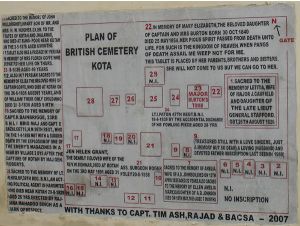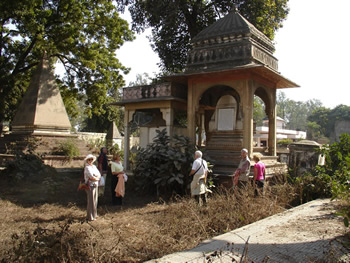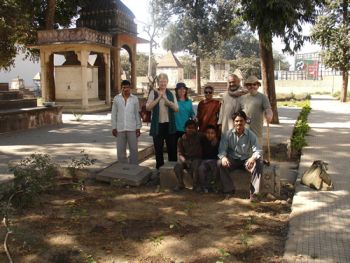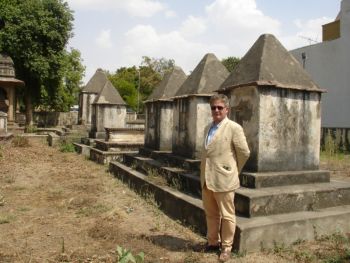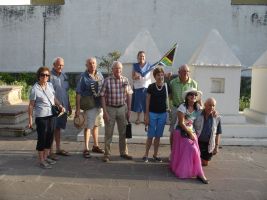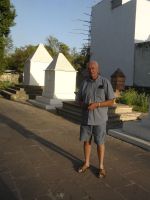The British Cemetery in Kota
An Overview
The main Kota Heritage Society project is the maintenance of the British Cemetery in Kota. This historic site suffers from being old, Christian and British and is therefore an embarrassment to most local people and the administration prefers not to be associated with it.
It is, however, a small but significant site being a concrete reminder of a period in Kota’s history when Kotah was an independent Rajput state but linked to events in the wider world through the controlling influences of the British in India.
There were very few British living in Kotah State and the Kotah Contingent (raised and run by the British but funded by Kotah for its defence) was forced to live on the periphery of the State at Deoli, on the road north.
Occasionally Political Agents, engineers, soldiers, surgeons and their wives and children would die while living and working in the area and they were buried in a plot of land, given for this purpose by the Maharao. Graves date from 1826 with the last known burial being in 1891. Soon after, the British Residency was moved to Bharatpur but the graves remained and are still there to this day. The most historically significant are of the officers and men who died in the Uprising of 1857/58. The most poignant are of the many young children.
The Cemetery was an overgrown tangle used by stray animals and drinkers as a haven. The British Association of Cemeteries in South East Asia came to know of it and gave money to INTACH for the conservation of the main graves. Later, the Urban Improvement Trust gave money for raising the boundary wall and some raised paths on condition that a system was put in place to maintain it. (They even tried to make a garden but this idea was never practical.)
The Kota Heritage Society is that system: a few local people with other friends and supporters who share the responsibility of paying for the upkeep of a small Heritage area in Kota for the benefit of future generations. We have produced a brochure so please download one or ask for one at your hotel.
Abid, seen here sitting front right, worked as a motor mechanic near the gate. He served as a chowkidar from the beginning of our project in 2007 until his untimely death on 31st August, 2020. He had been fit and well at the beginning of the covid-19 lockdown in March 2020 but died from a combination of stomach ulcers and uncontrolled blood sugar brought on by his lockdown lifestyle.
Abid is greatly missed. The responsibility for the cemetery is now shared between his elder brother Zaeed, who mends punctures near the cemetery gate, and Abid's son Adil, who is trying to support his mother and himself by selling chicken biryani outside the cemetery.
Adil and Zaeed keep the key to the cemetery gate and supervise Kamla Bai, the sweeper. They both look after the vistiors book known as the 'Diary'.
Please do write in the book as it is proof for the authorities that visitors are coming from around the world and appreciating our efforts. Since Independence the Cemetery has been owned by the Rajasthan Government.
We welcome inquiries from descendants of those buried in the Cemetery and try to help them but many of the graves no longer have their inscriptions. There are no surviving records of burials.
Frank Hancock visiting the cemetery on April 10th, 2011. His great great grandfather's brother was buried here in April 1858. Lt. Charles Hancock, a 21 year old sapper with the Bombay Engineers, died of wounds received while dismantling one of the rebels' guns during the battle to retake Kotah.
On Friday 21st March, 2014, the South African Titch Tours group were able to witness the transformation over the last three years. A large part of the cemetery has been paved, the monuments have been restored and re-painted, the path has been repaired and a pebble bed laid on geo-textile as a weed suppressant
Peter Hewitt is the great great grandson of Dr. Murray Salder who was killed in Kotah in 1857 and who is probably buried in this cemetery. Peter's niece, Shireen Griffiths, is Salder's great great great granddaughter and was also in the group.
Financial support and new members are always welcome.


